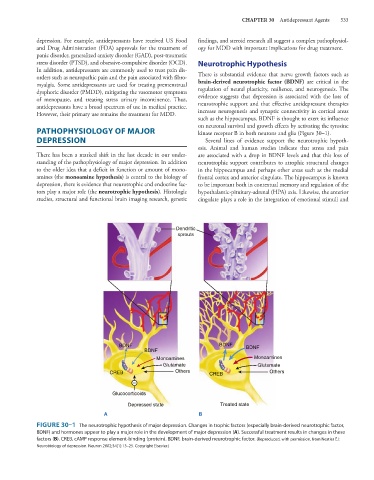Page 547 - Basic _ Clinical Pharmacology ( PDFDrive )
P. 547
CHAPTER 30 Antidepressant Agents 533
depression. For example, antidepressants have received US Food findings, and steroid research all suggest a complex pathophysiol-
and Drug Administration (FDA) approvals for the treatment of ogy for MDD with important implications for drug treatment.
panic disorder, generalized anxiety disorder (GAD), post-traumatic
stress disorder (PTSD), and obsessive-compulsive disorder (OCD). Neurotrophic Hypothesis
In addition, antidepressants are commonly used to treat pain dis-
orders such as neuropathic pain and the pain associated with fibro- There is substantial evidence that nerve growth factors such as
myalgia. Some antidepressants are used for treating premenstrual brain-derived neurotrophic factor (BDNF) are critical in the
dysphoric disorder (PMDD), mitigating the vasomotor symptoms regulation of neural plasticity, resilience, and neurogenesis. The
of menopause, and treating stress urinary incontinence. Thus, evidence suggests that depression is associated with the loss of
antidepressants have a broad spectrum of use in medical practice. neurotrophic support and that effective antidepressant therapies
However, their primary use remains the treatment for MDD. increase neurogenesis and synaptic connectivity in cortical areas
such as the hippocampus. BDNF is thought to exert its influence
on neuronal survival and growth effects by activating the tyrosine
PATHOPHYSIOLOGY OF MAJOR kinase receptor B in both neurons and glia (Figure 30–1).
DEPRESSION Several lines of evidence support the neurotrophic hypoth-
esis. Animal and human studies indicate that stress and pain
There has been a marked shift in the last decade in our under- are associated with a drop in BDNF levels and that this loss of
standing of the pathophysiology of major depression. In addition neurotrophic support contributes to atrophic structural changes
to the older idea that a deficit in function or amount of mono- in the hippocampus and perhaps other areas such as the medial
amines (the monoamine hypothesis) is central to the biology of frontal cortex and anterior cingulate. The hippocampus is known
depression, there is evidence that neurotrophic and endocrine fac- to be important both in contextual memory and regulation of the
tors play a major role (the neurotrophic hypothesis). Histologic hypothalamic-pituitary-adrenal (HPA) axis. Likewise, the anterior
studies, structural and functional brain imaging research, genetic cingulate plays a role in the integration of emotional stimuli and
Dendritic
sprouts
BDNF BDNF BDNF
BDNF
Monoamines Monoamines
Glutamate Glutamate
CREB Others CREB Others
–
Glucocorticoids
Depressed state Treated state
A B
FIGURE 30–1 The neurotrophic hypothesis of major depression. Changes in trophic factors (especially brain-derived neurotrophic factor,
BDNF) and hormones appear to play a major role in the development of major depression (A). Successful treatment results in changes in these
factors (B). CREB, cAMP response element-binding (protein). BDNF, brain-derived neurotrophic factor. (Reproduced, with permission, from Nestler EJ:
Neurobiology of depression. Neuron 2002;34[1]:13–25. Copyright Elsevier.)

